Expert Rabbit Care Tips, Ideal Diet, Fun
Toys & Cosy Cage Ideas
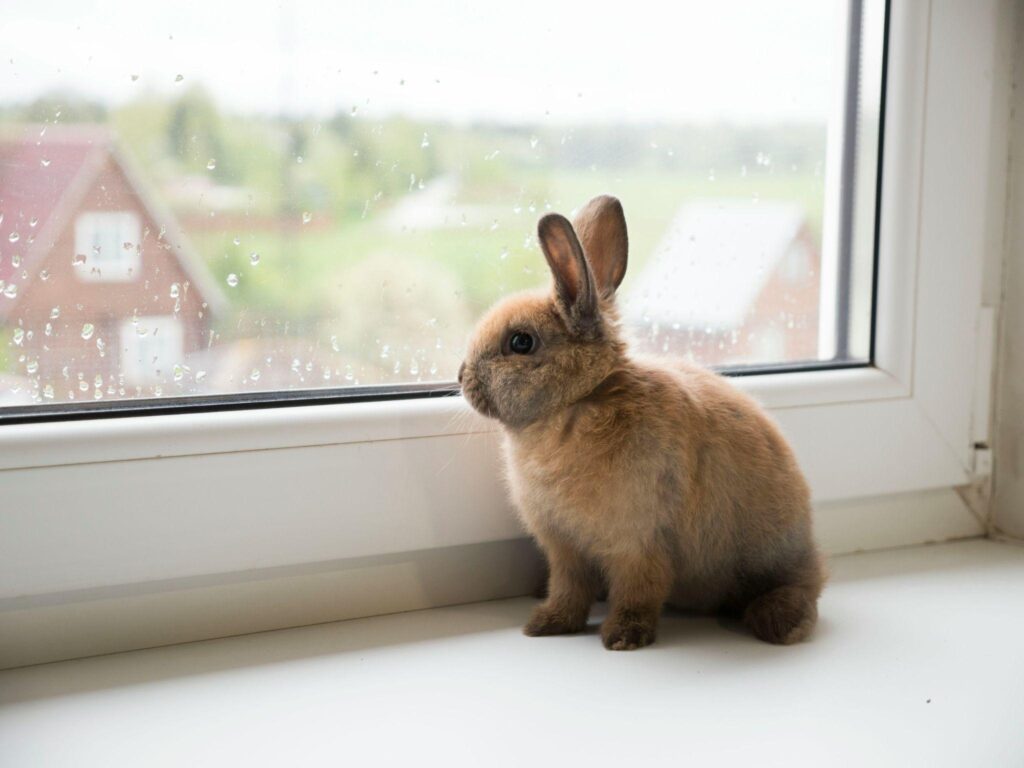
Understanding Bunny:
Every Easter, lots of parents give in to the “Easter bunny temptation” and buy a rabbit for their kids.
Once the “bunny fever” goes away, though, many people leave their new purchases alone in small
outdoor cages called hutches, drop them off at animal shelters, or release them outdoors, where
they often starve or are killed by predators. Most bunnies purchased as “pets” end up dead or
abandoned by their first birthday.
When you adopt a rabbit, you quickly learn that they’re very particular about their territory. They
need lots of space and have specific spots where they like to eat, sleep, and use the “bathroom”
(kind of like humans!). If you invade a bunny’s space, they may grunt at you so that you know to back
off.
Bunnies don’t sleep at night and stay up during the day like humans do, either. They are crepuscular.
Yup, there’s that word again! It means they’re most active at dusk and dawn.
These symptoms aren’t necessarily signs of neglect, but they are signs that a bunny needs to see a
vet: a runny nose, sneezing, a head tilt, listlessness, and diarrhea. If you have a bunny or see
someone else’s, keep an eye out for these symptoms! Be sure to have your bunny spayed or
neutered. Like dogs and cats, bunnies live longer and are healthier when they’re spayed or neutered.
In female rabbits, the risk of reproductive cancer (which is deadly) is a whopping 80% before they’re
spayed!
They need opportunities to socialize, lots of space to run around, and plenty of toys to keep them
entertained—otherwise, they can become withdrawn or depressed. Some common household items,
like paper towel rolls and cardboard oatmeal canisters, can make for bunny games. Just fill them with
timothy hay and watch as your bunny rolls, chews, and plays joyfully. ♥
Yup, that’s right. Bunnies need to digest some of their food twice. Healthy bunnies eat soft
“cecotropes” (nutrient-packed droppings) that look like poop. The hard, round pellets you see are
from the second round of digestion. When you think about it, it’s pretty cool!
Rabbit Diet: What Should Your Bunny Eat?
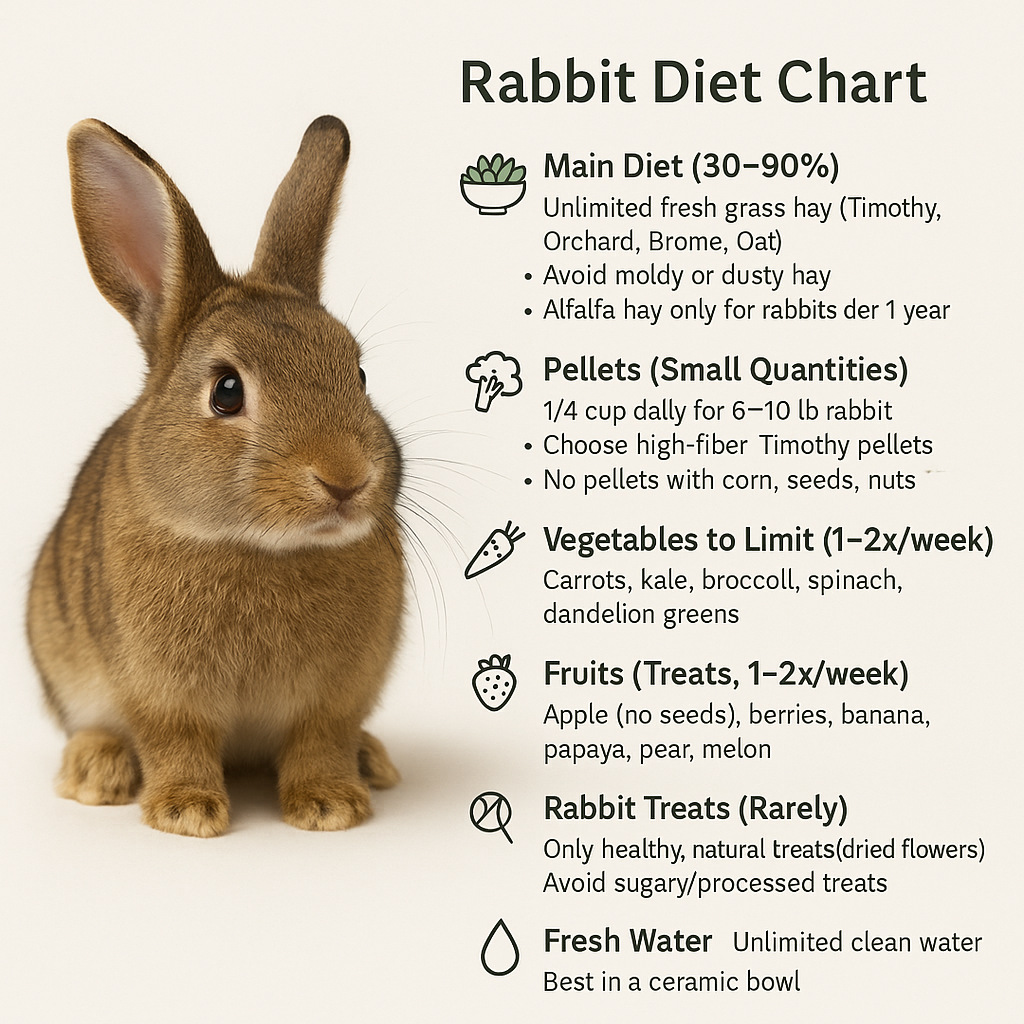
Rabbit Care: Building the Basics
Shedding:
● Rabbits shed every three months, alternating between light and heavy shedding.
● They groom themselves like cats but cannot vomit; hairballs can cause deadly
blockages.
● Brush rabbits at least weekly and daily during heavy shedding periods.
● Some rabbits shed gradually; others shed quickly and need extra care.
● Bald spots are common and usually regrow within a week or two.
Long-Haired Rabbits:
Long-haired rabbits are beautiful but require much more care than short-haired ones.
It’s best to trim their hair to one inch or less using scissors to help prevent hairballs. If you’re
not comfortable grooming them yourself, seek expert help — your veterinarian can show you
how to safely trim and care for your rabbit’s coat.
Fleas and Mites:
Safe flea treatments for rabbits include Advantage, Program, and Revolution, with Revolution
preferred for mites, too. Apply treatments carefully with a tuberculin syringe and clean cages
thoroughly. Flea combs offer a non-toxic option. Avoid Frontline, flea powders, flea shampoos, and
flea baths, as they can harm or kill rabbits. Use safer environmental controls like borax or
diatomaceous earth.
Baths:
Most rabbits dislike water; baths are very stressful and not recommended unless a vet advises it to
reduce fever. Bathing sick rabbits can cause shock or death. Instead, spot-clean dirty areas with
baby cornstarch (not talcum) and a flea comb. A wet rabbit must be thoroughly blow-dried (only in a
“warm” setting) to prevent hypothermia.
Mats:
Rabbit skin is delicate; mats should be removed with a mat splitter or rake, not scissors.
Skin:
Scratchy, flaky skin usually indicates mites or flea allergies; treatment is noted under “Fleas.” See a
vet for open sores or chronic issues.
Scent Glands:
Clean the scent glands near the anus with a Q-tip dipped in warm water, gently swabbing the brown
buildup.
Feet:
Rabbits need regular toenail trims, like cats and dogs. Declawing is not safe. Provide hay boxes for
digging. If foot fur wears down, offer soft rugs and keep litter areas clean to prevent infection.
Incontinence:
Infected or disabled rabbits may have wet fur. Shave wet areas, rinse daily,and apply cornstarch
powder, and consider baby diapers (e.g., Huggies Step 2 for an 8 lb rabbit).
Ears:
Clean earwax with a cotton swab (carefully). For mites, use Mitox or vet-prescribed Ivermectin.
Teeth:
Rabbit teeth grow continuously. Check during grooming. Normal chewing wears them down, but
Rabbits with crooked teeth need regular trimming with clippers to avoid starvation.
Nails:
Trim nails every 6–8 weeks. Light nails are easier to clip. For dark nails, clip carefully. If bleeding
occurs, use Kwik Stop or pressure with a cotton ball. Vets can trim nails if needed.
Eyes:
Watery eyes need a vet diagnosis. Keep cheeks clean and dry to prevent fur loss. Use ophthalmic
saline to clean tears, and flea comb gently. The anesthetic powder may ease painful lesions.
Common health issues and how to monitor them.
1. Overgrown teeth:
One of the most common dental problems in rabbits is overgrown teeth, as their teeth grow continuously, like other small pets. Providing unlimited feeding hay (e.g., Timothy Hay) helps wear teeth down naturally. Overgrown teeth can hinder eating and drinking, and sharp spurs may cut the gums and tongue. Malocclusion (misaligned teeth) prevents natural wear and may require regular dental treatments or tooth removal. Check your rabbits’ teeth regularly to catch problems early. Watch our video to learn how.
Symptoms of dental disease in rabbits:
● If your rabbits are showing any of these symptoms, take them to see a vet as soon as
possible.
● Overgrown teeth
● Weight loss.
● A dirty bottom—because grooming becomes difficult and painful.
● Diarrhea or soft feces.
● Weepy eyes and white sticky discharge around the eyes.
● Drooling
● Reduced appetite and picky eating – they may also drop food when eating.
● Tooth Grinding
● A bumpy, painful jaw.
● Lethargy (low energy)
If your rabbit stops eating, this is an emergency situation. They are at risk of gut stasis
and will need to see a vet immediately.
2. Snuffles (Upper Respiratory Infection :
Snuffles (an upper respiratory infection) is a serious rabbit illness that can cause sudden death
if untreated. It’s mainly caused by Pasteurella and Bordetella bacteria. Stress, sickness, or poor
living conditions trigger infections. Prevent it by reducing stress, providing clean, spacious,
well-ventilated areas, and a proper diet. It spreads through direct contact or contaminated
objects. Isolate sick rabbits, clean them thoroughly, and don’t reintroduce them until fully
recovered. Watch for warning signs—cold-like symptoms in rabbits need immediate vet care.
Symptoms of snuffles (URI) in rabbits:
● Weepy eyes
● Discharge from the nose
● Sneezing/snuffles
● Fast or difficult breathing
● Wheezing or noisy breathing
● Low energy, quietness, or hiding away
● Loss of appetite and weight loss
● Stained fur on front legs from cleaning weepy eyes and runny nose.
3. Flystrike:
Flystrike (‘myiasis’) is a life-threatening condition where flies lay eggs on rabbits, leading to
maggots burrowing into their skin. It can cause severe damage within a day, requiring
immediate vet attention. Causes include warm weather, dirty bottoms, wounds, or dirty
enclosures. Prevent it with daily cleaning, health checks, and vet-recommended flystrike
treatments—never use general insect repellents or flea treatments on rabbits.
Symptoms of flystrike in rabbits:
● Maggots in the fur or under the skin
● Patches of wet fur and fur loss (often around the back end)
● Open wounds or sores containing fly eggs or maggots
● Lethargy (low energy)
● Eating less
● A bad smell
● Collapse
4. Rabbit-specific diseases:
Just like cats and dogs, rabbits need regular vaccinations to stay healthy. Two major diseases
are myxomatosis and rabbit viral hemorrhagic disease (RHD), both fatal in most cases.
Vaccinate rabbits from 5–7 weeks of age and yearly thereafter. Keep enclosures clean, use mosquito
netting, and only use UK-licensed rabbit flea treatments. Quarantine new rabbits for three
weeks.
Symptoms of myxomatosis in rabbits:
● Swelling around the eyes, face, ears, and genitals
● Weepy eyes (milky), runny nose
● Skin lumps, ulcers, and scabs
● Low energy (lethargy)
● Difficulty eating or drinking
● Breathing problems
● High temperature (fever)
Symptoms of RHD in rabbits:
● Blood around the nose, mouth, or bottom
● Low energy (lethargy)
● Eating less (can be fatal)
● High temperature
● Sudden death (often without warning)
5. Skin Parasite:
Rabbits can pick up fleas, mites, and lice, causing itching, fur loss, and painful sores if
untreated. Check any new rabbits before introducing them to others. Speak to a vet for
rabbit-safe treatments—never use products meant for cats or dogs. Keep your rabbits’ home
clean, groom them regularly, and use dust-extracted hay and straw.
Symptoms of skin parasites in rabbits:
● Excessive scratching or overgrooming
● Fur loss
● Sore, red, flaky skin
● Scabs and crusty areas
● Black specks in fur or on skin
● Visible insects crawling in the fur.
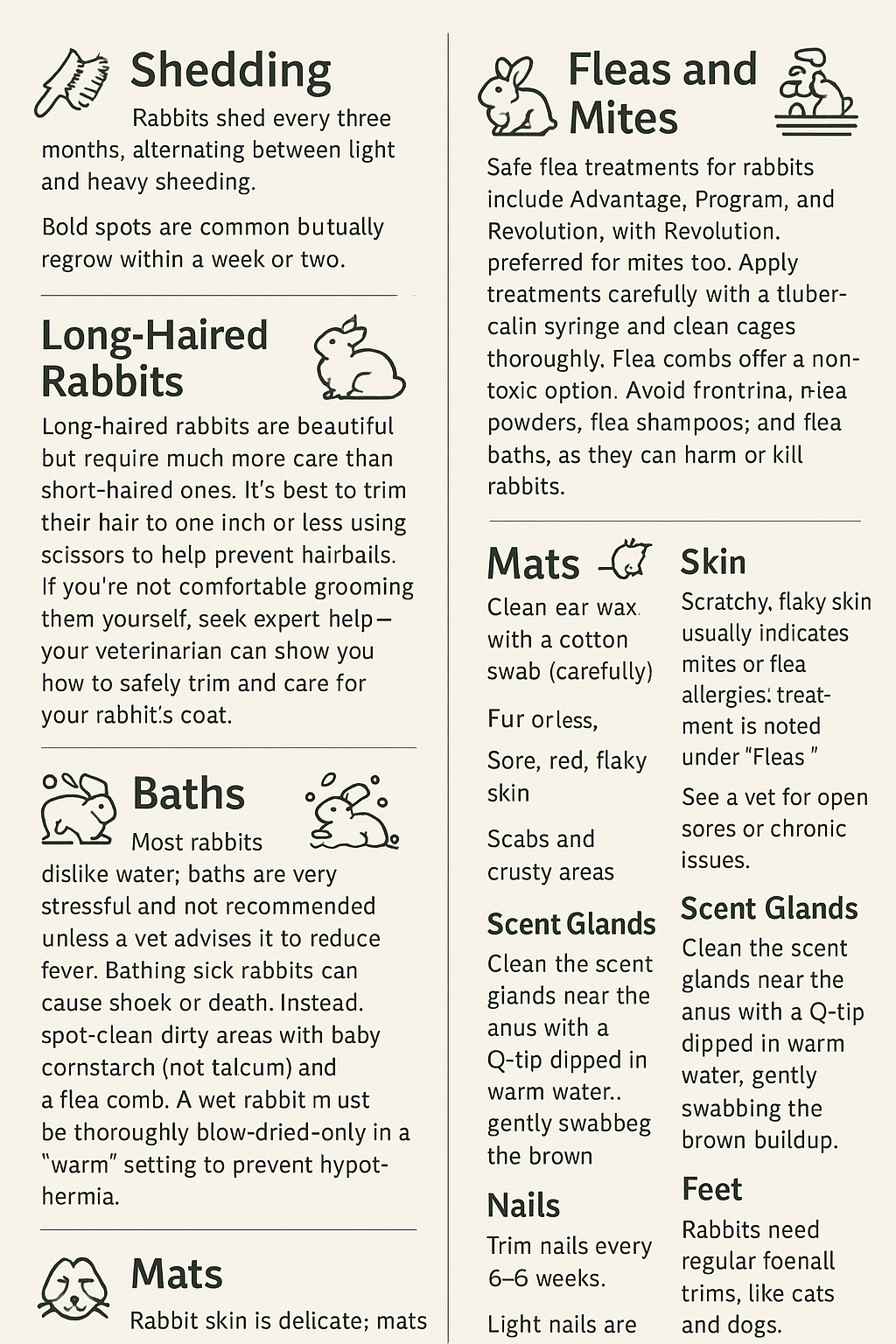
Rabbit Cage Setup: Creating a
Safe and Comfy Home
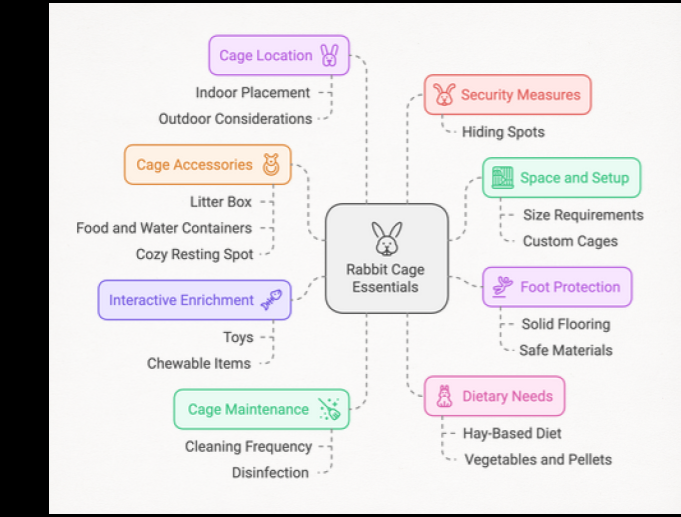
Rabbit Toys: Keep Your Bunny
Engaged and Happy
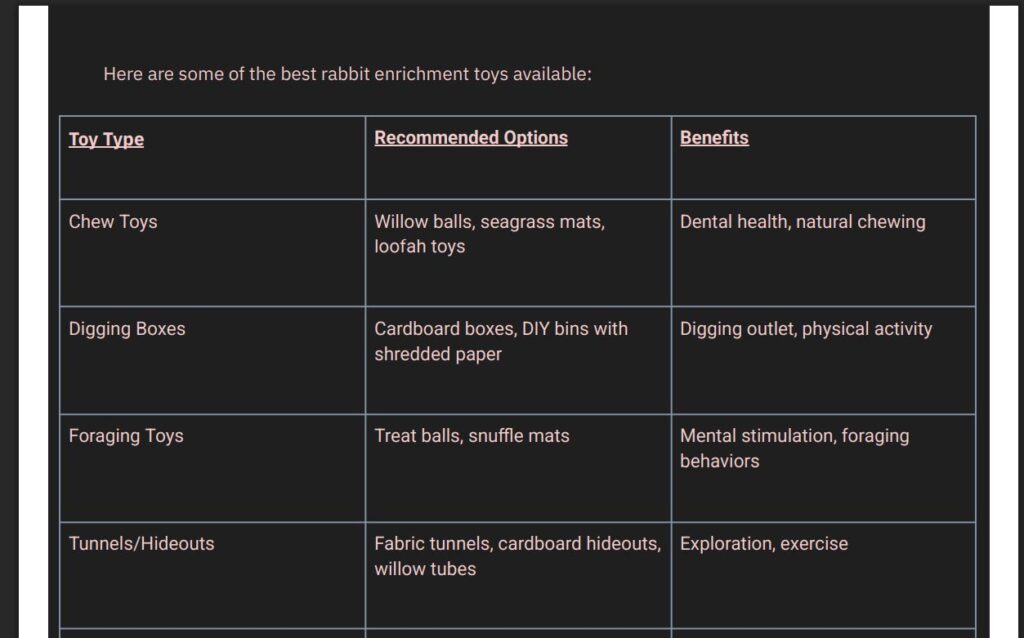
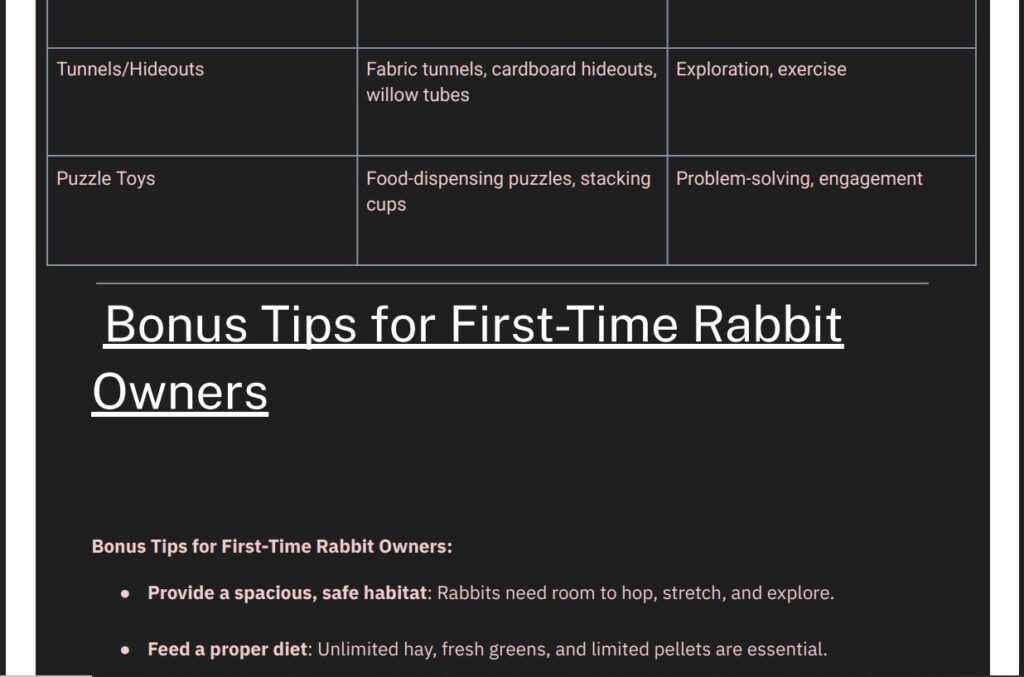
● Groom regularly: Brush your rabbit weekly, more during shedding seasons.
● Litter trains your rabbit: Rabbits can be trained to use a litter box easily.
● Handle gently: Always support their body properly when lifting them.
● Keep them social: Rabbits are happier with companionship—either from you or another
rabbit.
● Visit a rabbit-savvy vet: Regular checkups and vaccinations are important.
● Rabbit-proof your home: Protect cords, furniture, and plants from curious chewing.
● Provide toys and enrichment: chew toys, tunnels, and digging boxes to prevent boredom.
● Learn their body language: Understanding your rabbit’s signals helps build a stronger bond
Conclusion:
Bringing a rabbit into your home is a joyful and rewarding experience, but it comes with important
responsibilities. From providing a balanced diet rich in hay and fresh vegetables to ensuring plenty of
space, mental stimulation, and regular veterinary care, every aspect of their well-being needs
careful attention. Understanding their unique needs — from grooming routines and parasite
prevention to safe housing and engaging toys — can help your rabbit live a long, happy, and healthy
life.
Remember, rabbits are intelligent, social creatures who thrive on love, patience, and proper care.
With the right knowledge and commitment, you’ll meet their needs and build a deep, trusting bond
that will fill your life with endless joy. Here’s to a “Happy Bunny, Healthy Life!” 🐰�

